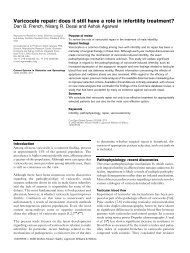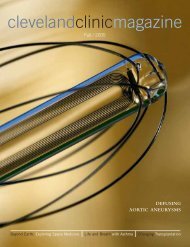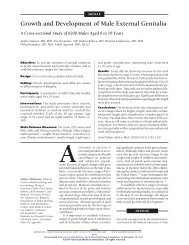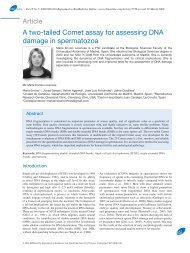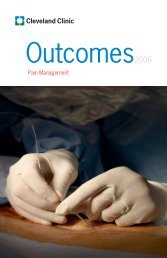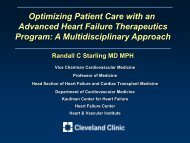Preimplantation genetic screening: does it help or ... - ResearchGate
Preimplantation genetic screening: does it help or ... - ResearchGate
Preimplantation genetic screening: does it help or ... - ResearchGate
You also want an ePaper? Increase the reach of your titles
YUMPU automatically turns print PDFs into web optimized ePapers that Google loves.
834 J Assist Reprod Genet (2011) 28:833–849<br />
Chromosomal abn<strong>or</strong>mal<strong>it</strong>y<br />
There are two types of chromosomal abn<strong>or</strong>mal<strong>it</strong>ies:<br />
numerical and structural. In regards to numerical abn<strong>or</strong>mal<strong>it</strong>ies,<br />
the add<strong>it</strong>ion <strong>or</strong> deletion of an entire chromosome<br />
is called aneuploidy, and the add<strong>it</strong>ion <strong>or</strong> deletion of an<br />
entire set of chromosomes is referred to as polyploidy and<br />
haploidy, respectively. Aneuploidy occurs in approximately<br />
20% of cleavage-stage human embryos [9]. It also occurs in<br />
45% of cleavage-stage embryos taken from patients w<strong>it</strong>h<br />
advanced maternal age (AMA; >36 years) [10]. Polyploidy<br />
and haploidy occur much less frequently (in 7% and 3%<br />
cleavage-stage embryos, respectively) [10]. Embryos classified<br />
as abn<strong>or</strong>mal on day 3 reached the blastocyst stage at a<br />
40% rate if they were trisomic (having a third copy of a<br />
particular chromosome), 21% if polyploid (containing m<strong>or</strong>e<br />
than 2 sets of chromosomes) and 0% if haploid <strong>or</strong><br />
monosomic (having one less than the diploid number of<br />
chromosomes)—this was true f<strong>or</strong> all chromosomes except<br />
f<strong>or</strong> chromosome X <strong>or</strong> 21 [11]. M<strong>or</strong>e recent studies using<br />
comparative genomic hybridization (CGH) indicate that the<br />
trisomy to monosomy ratio is 60:40 [12].<br />
Structural chromosomal abn<strong>or</strong>mal<strong>it</strong>ies can occur spontaneously<br />
<strong>or</strong> as a result of external f<strong>or</strong>ces such as radiation.<br />
Numerical and structural abn<strong>or</strong>mal<strong>it</strong>ies can be present<br />
concurrently.<br />
Embryos can also be mosaic, that is, they contain several<br />
cell lines w<strong>it</strong>h different chromosome complements. Mosaicism<br />
may have <strong>or</strong>iginated and persisted as a result of the low<br />
expression of certain cell cycle checkpoint genes during the<br />
first cell divisions in the early developing embryo. During this<br />
period, maternal transcripts control the cell cycle until the<br />
cleavage stage, which is where the embryonic genome takes<br />
over. It is believed that the once the embryonic genome<br />
becomes fully active, <strong>it</strong> can overcome mosaicism by<br />
perm<strong>it</strong>ting n<strong>or</strong>mal cells to proliferate and inhib<strong>it</strong> abn<strong>or</strong>mal<br />
cells from m<strong>it</strong>otic activ<strong>it</strong>ies [13].<br />
We will focus primarily on numerical chromosomal<br />
abn<strong>or</strong>mal<strong>it</strong>ies in the current review. Aneuploidy can persist<br />
through implantation and may result in a live birth f<strong>or</strong> trisomy<br />
21 (Down syndrome), trisomy 13 (Patau syndrome), trisomy<br />
18 (Edwards syndrome), monosomy X (Turner syndrome),<br />
trisomy XXY (Klinefelter syndrome), and other gonosomal<br />
const<strong>it</strong>utive aneuploidies. At the cleavage stage, aneuploidies<br />
affect chromosomes 15, 16, 21 and 22 most frequently and<br />
chromosomes X and Y least frequently [14].<br />
What is the prevalence of PGS in the clinical setting?<br />
The European Society of Human Reproduction and<br />
Embryology (ESHRE) PGD Cons<strong>or</strong>tium collects PGD data<br />
from a small number of clinics w<strong>or</strong>ldwide [15]. Acc<strong>or</strong>ding<br />
to this <strong>or</strong>ganization, 66% of the PGD cycles were used as<br />
aneuploidy <strong>screening</strong>, <strong>or</strong> PGS. Although the precise<br />
number of clinics practicing PGS w<strong>or</strong>ldwide is unknown,<br />
there is evidence of a growing trend [15, 16].<br />
Evolution of PGS: from sex selection to embryo qual<strong>it</strong>y<br />
In<strong>it</strong>ially, the aim of PGD was to detect embryos at risk f<strong>or</strong><br />
inher<strong>it</strong>ing monogenic diseases from the parents. PGD was<br />
first used f<strong>or</strong> gender determination in couples who were<br />
carriers of sex-linked dis<strong>or</strong>ders. In that case, DNA<br />
amplification was perf<strong>or</strong>med followed by PCR f<strong>or</strong> a<br />
specific repeated gene sequence on the Y-chromosome [1].<br />
PCR was found to be less effective in determining gender<br />
since <strong>it</strong> produces qual<strong>it</strong>ative and not quant<strong>it</strong>ative data,<br />
meaning the test results could confirm the sex by<br />
highlighting the presence <strong>or</strong> absence of a specific repeated<br />
gene sequence unique to the Y-chromosome w<strong>it</strong>hout<br />
providing further inf<strong>or</strong>mation on the existence of an X <strong>or</strong><br />
Y chromosome. To overcome this disadvantage, flu<strong>or</strong>escent<br />
in s<strong>it</strong>u hybridization (FISH) was subst<strong>it</strong>uted [17].<br />
The use of FISH w<strong>it</strong>h X and Yprobes was later expanded to<br />
include somatic chromosomes. In 1993, Munne et al. used the<br />
FISH procedure to detect chromosomal abn<strong>or</strong>mal<strong>it</strong>ies f<strong>or</strong> five<br />
chromosomes and thus perf<strong>or</strong>med the first cases of PGS [17].<br />
It is well known that chromosomal abn<strong>or</strong>mal<strong>it</strong>ies play a<br />
maj<strong>or</strong> role in failed embryo implantation after in v<strong>it</strong>ro<br />
fertilization (IVF) treatment. Thus, <strong>it</strong> was hypothesized that<br />
identifying such preimplantation embryos would improve<br />
implantation rates. PGS was used to increase implantation<br />
rates and live births while reducing spontaneous ab<strong>or</strong>tions<br />
(“treatment benef<strong>it</strong>”) by determining the aneuploidy status of<br />
the embryos (“diagnostic benef<strong>it</strong>”)inpatientsw<strong>it</strong>hnoknown<br />
<strong>genetic</strong> dis<strong>or</strong>der.<br />
Munne et al. 1995 [18] and Verlinsky et al. 1996 [19]<br />
perf<strong>or</strong>med PGS using FISH in first and second polar bodies<br />
(PBs). However, the use of FISH w<strong>it</strong>h cleavage-stage<br />
embryos became m<strong>or</strong>e commonplace except in areas where<br />
policies prohib<strong>it</strong>ed such activ<strong>it</strong>y. The first clinical studies on<br />
cleavage-stage embryos showed increases in implantation<br />
and ongoing pregnancy rates as well as and decreases in<br />
spontaneous ab<strong>or</strong>tion rates [6, 20–24]. Even so, <strong>it</strong>s use is<br />
still considered controversial as investigations to validate<br />
the use of PGS have yielded contradicting results.<br />
As media culture perm<strong>it</strong>ted the growth of embryos to the<br />
blastocyst stage, PGS evolved to include trophectoderm cell<br />
biopsy [25]. Here, several trophectoderm cells are removed<br />
and screened f<strong>or</strong> aneuploidy using FISH <strong>or</strong> CGH instead of<br />
one <strong>or</strong> two blastomeres w<strong>it</strong>h cleavage-stage biopsy [25, 26].<br />
McArthur et al. 2005 rep<strong>or</strong>ted the first routine use of<br />
blastocyst biopsy w<strong>it</strong>h FISH in human preimplantation<br />
embryos to produce successful pregnancies and live births.



